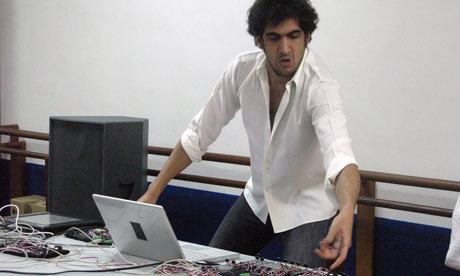Can Cambodia begin to rebuild its shattered cultural heritage? Tim Etchells wonders if the answer lies with a team of Khmer dancers ... and a specially modified laptop.
- guardian.co.uk,
- Tuesday 9 February 2010

Dancing to a new tune ... Tarek Atouil plays a series of sounds collected by Khmer dancers from his laptop. Photograph: Tim Etchells
I've recently returned from two weeks in Cambodia, travelling with 18 other artists, dancers, choreographers and performance-makers at the invitation of Ong Keng Sen's Flying Circus Project. Based in Singapore, Keng Sen's Theatre Works outfit has been running these exchanges – predominantly Asian in focus, but with routes out in all directions – for something like 10 years. The intention varies with each incarnation, but the broad hope is for a two-way artistic exchange between invited and local artists, and between the invited artists themselves. To call this latter group diverse would be an understatement: our trip saw passports from Indonesia, Slovenia, Turkey, South Africa, India, UK, Lebanon, Singapore, USA and Austria, among others, landing on the immigration desk in Phnom Penh.
Highly organised and efficient on one hand, Flying Circus also courts a creative openness that at times borders on chaos. The logic for Keng Sen is that the encounter must have its own energy, that the group itself must conjure something new from the situation. An approach like this takes time and nerve, but it undoubtedly pays off.
Looking back, it's hard to say what made the biggest impression on me. The country itself remains blighted by poverty, and still in recovery from the devastation of the Pol Pot era and subsequent years of civil war and instability. Culturally, there's a determined attempt to recover what the Khmer Rouge tried to wipe out in its brutal five-year drive to Year Zero, which involved – alongside much else – killing intellectuals, artists, teachers and anyone who spoke French. For this reason, there's much talk of archives, of remembering and preserving. Around 300 feature films were made in Cambodia before 1975, of which as few as 30 now survive. They have been gathered in the last five years and preserved along with other film, sound and photographic materials at the Bophana archive in Phnom Penh, our base for half of the workshops.
The situation is equally dire in the performing arts, since only a handful of classical Khmer dancers survived the killing fields. These old masters are now a precious resource, teaching new generations techniques that otherwise would have slipped away for good. Back home in England, I generally run a mile from people attempting to rescue traditional forms; but in Cambodia, the initiative made more sense – the difference, perhaps, between a past that is dying from irrelevance or lack of interest, and one that has only recently survived assassination.
What I sensed in the younger artists and dancers we worked with, though, was a desire to move forwards with the past, and not to retreat into it. These Cambodian twentysomethings are savvy and hungry, and well aware that their country is opening up, and that internationally financed redevelopment and tourism have been following the inflow of NGOs. They know that they'll need new approaches in the arts, and new political voices to meet the challenges ahead.
I asked Keng Sen what he feared the most from his project. We talked about economic and political dangers (artists as the vanguard for property developers) and about the cultural dangers (Cambodians caught in retreading western postmodern art practice). Then we talked about the positives: the meetings, the collisions, the insistence on and the articulation of differences. There was one moment in the workshops that crystallised these possibilities for me. Tarek Atoui, Lebanese sound artist, ran a session with the Khmer participants that involved sounds collected by the dancers played out from a laptop and a complex array of homemade sensors, motion triggers and pressure pads. It was late in the afternoon when the dancers from Amrita Performing Arts, our hosts for half of the project, took to their feet and began to move in and around Atoui's machinery.
What happened was tentative at first, then suddenly too much. It was as if the dancers wanted to play the system, or make music with it, rather than dance with it. My heart sank. Then all at once they turned a corner and were dancing again – the turning wrists and fingers, lowered centres of gravity, eye contact, pantomime pauses and forward rolls all instantly recognisable from Khmer classical forms. They weren't dancing for the electronics, nor were they dancing with them exactly; they were dancing with and against them, entering and refusing, insisting on and moving through. There was tension in the dancing and music that afternoon, just as there should be on occasions of meeting. It was a privilege and an inspiration to be there.

No comments:
Post a Comment